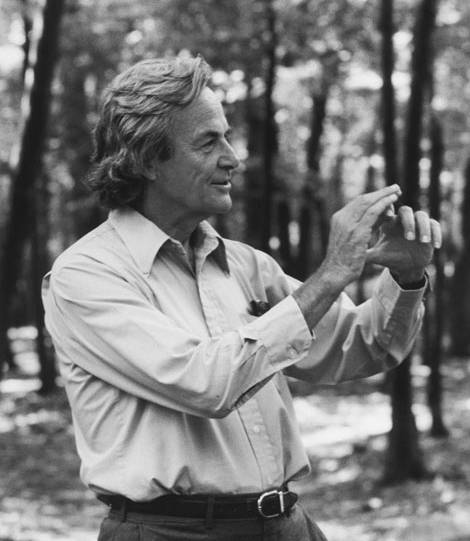
FAQ About Richard Feynman

Who was Richard Feynman?
Richard Feynman was an American physicist known for his work in quantum mechanics, quantum electrodynamics, and particle physics. He was a professor at the California Institute of Technology and a key figure in the development of the atomic bomb during the Manhattan Project. Feynman won the Nobel Prize in Physics in 1965 along with Julian Schwinger and Shinichiro Tomonaga for their contributions to the development of quantum electrodynamics.

What is Richard Feynman famous for?
Richard Feynman is famous for his groundbreaking work in quantum mechanics and the development of Feynman diagrams, a tool for visualizing and calculating interactions in particle physics. He also became well-known to the general public through his popular science books and lectures, which made complex scientific ideas accessible to a wider audience. Notably, he contributed to the investigation of the Space Shuttle Challenger disaster by exposing the technical failures that led to the tragedy.

What are Feynman diagrams?
Feynman diagrams are graphical representations created by Richard Feynman to visualize and calculate the behavior of subatomic particles. These diagrams simplify the complex equations of quantum electrodynamics by providing a visual way to track particle interactions, such as the exchange of photons between electrons. Today, they are a crucial tool in theoretical physics and have greatly aided in the understanding and communication of quantum mechanics.

What contributions did Richard Feynman make to quantum electrodynamics?
Richard Feynman made significant contributions to quantum electrodynamics (QED), particularly through his development of path integral formulation and Feynman diagrams. His work helped resolve several theoretical problems in QED by providing more intuitive and computationally efficient methods for understanding and predicting how particles interact with electromagnetic fields. He shared the 1965 Nobel Prize in Physics for these contributions.

Which books did Richard Feynman write?
Richard Feynman authored several popular science books, including "Surely You're Joking, Mr. Feynman!", "The Feynman Lectures on Physics", "What Do You Care What Other People Think?", and "QED: The Strange Theory of Light and Matter". These books are known for their engaging style and ability to explain complex scientific concepts to a broad audience.

What was Richard Feynman's role in the Manhattan Project?
During the Manhattan Project, Richard Feynman worked at the Los Alamos Laboratory, where he was involved in the development and construction of the atomic bomb. He was part of the Theoretical Division, working on nuclear physics problems related to bomb design. Feynman is noted for his work on calculating neutron diffusion and his ability to motivate and manage other scientists and technicians in this high-pressure environment.

How did Richard Feynman contribute to the investigation of the Challenger disaster?
Richard Feynman was a member of the Rogers Commission, the panel that investigated the Space Shuttle Challenger disaster in 1986. His most famous contribution was demonstrating how the shuttle's O-rings, used to seal joints in the booster rockets, became brittle and failed in cold temperatures. He famously illustrated this problem during a televised hearing by immersing an O-ring sample in ice water, showing its loss of flexibility and thereby pinpointing a critical factor in the disaster.

What is 'The Feynman Lectures on Physics'?
'The Feynman Lectures on Physics' is a comprehensive series of introductory physics textbooks based on lectures given by Richard Feynman at the California Institute of Technology between 1961 and 1963. The series is praised for its clarity, insight, and engaging style. It covers a wide range of topics in physics, from basic principles to more complex concepts, and is used worldwide as an important educational resource.

What is the Feynman Technique?
The Feynman Technique is a mental model for learning and understanding a topic by simplifying it into basic concepts. It involves four steps: 1) Choose a concept and write down everything you know about it, 2) Teach it to someone else or pretend to teach it, using simple language, 3) Identify gaps in your understanding and go back to the source material if necessary, 4) Review and simplify further, refining your understanding. This technique encourages active learning and deep comprehension.

Which academic institutions was Richard Feynman associated with?
Richard Feynman was associated with several academic institutions throughout his career. He received his bachelor's degree in physics from the Massachusetts Institute of Technology (MIT) and earned his Ph.D. from Princeton University. He was a faculty member at Cornell University before joining the California Institute of Technology (Caltech), where he spent most of his academic career and made many of his significant contributions to physics.

How did Feynman's approach to teaching influence science education?
Feynman's approach to teaching was characterized by his ability to simplify complex topics and engage students through storytelling and demonstrations. His emphasis on intuition over rote memorization and his knack for making physics relatable had a lasting impact on science education. His teaching philosophy encouraged analytical thinking, curiosity, and the practical application of scientific principles, which continue to inspire educators around the world.

What is 'Surely You're Joking, Mr. Feynman!' about?
'Surely You're Joking, Mr. Feynman!' is a collection of anecdotes and personal reflections by Richard Feynman, compiled by Ralph Leighton. The book covers various aspects of Feynman's life, including his work as a physicist, his hobbies such as safe-cracking and playing the bongo drums, and his adventures throughout his career. Renowned for its wit and humor, the book provides insight into the mind and character of Feynman, appealing to both scientists and general readers.

What was Richard Feynman's educational background?
Richard Feynman was educated in the United States, where he demonstrated exceptional talent in science and mathematics from an early age. He completed his undergraduate studies in physics at the Massachusetts Institute of Technology (MIT) and went on to earn his Ph.D. in theoretical physics from Princeton University. His doctoral thesis on the principle of least action in quantum mechanics set the stage for his significant contributions to the field.

Did Richard Feynman receive any notable awards?
Yes, Richard Feynman received several notable awards during his lifetime. The most prestigious was the Nobel Prize in Physics, which he received in 1965, shared with Julian Schwinger and Shinichiro Tomonaga for their work in quantum electrodynamics. Feynman was also honored with the National Medal of Science, awarded in 1979, among other accolades recognizing his contributions to physics and education.

How did Richard Feynman influence popular science?
Richard Feynman greatly influenced popular science through his engaging public lectures, accessible books, and his distinct ability to communicate scientific ideas with clarity and enthusiasm. His efforts helped demystify complex subjects, making them understandable and intriguing to lay audiences. Feynman inspired a generation of scientists and science enthusiasts, emphasizing the joy of discovery and the importance of curiosity in the sciences.

What hobbies did Richard Feynman have?
Richard Feynman had a wide range of hobbies that reflected his diverse interests and curious nature. He was an avid bongo drum player and took part in various art projects, including drawing and painting. Feynman also enjoyed safe-cracking and developed an interest in languages, particularly for fun activities such as creating his own words. His hobbies often reflected his scientific approach—analyzing and experimenting with the world around him.

Where was Richard Feynman born?
Richard Feynman was born on May 11, 1918, in Queens, New York City. Raised in a family that encouraged curiosity and exploration, his upbringing played a significant role in shaping his later scientific achievements. Feynman's early fascination with science and engineering laid the foundation for his illustrious career in physics.

What is the legacy of Richard Feynman?
Richard Feynman's legacy is vast, encompassing his contributions to theoretical physics, science education, and popular science communication. His work on quantum electrodynamics, particularly through Feynman diagrams, revolutionized the field, while his enthusiastic public engagement inspired countless individuals to pursue science. Feynman's unique blend of scientific brilliance and relatability continues to resonate in both academic and popular contexts.

What impact did Richard Feynman have on quantum mechanics?
Richard Feynman had a profound impact on quantum mechanics through his development of the path integral formulation and Feynman diagrams, which provided new approaches to understanding and solving problems in quantum physics. His innovations allowed for more intuitive and practical methods of analysis, making complex concepts more accessible and playing a crucial role in advancing the field of quantum mechanics.

Did Richard Feynman collaborate with other famous scientists?
Yes, throughout his career, Richard Feynman collaborated with several famous scientists. During the Manhattan Project, he worked alongside prominent figures such as J. Robert Oppenheimer, Hans Bethe, and Niels Bohr. His collaborations extended into his later academic work, engaging with peers across various fields in physics and contributing to numerous scientific advancements. Feynman's collaborative spirit and interdisciplinary approach were critical to his success and influence.
